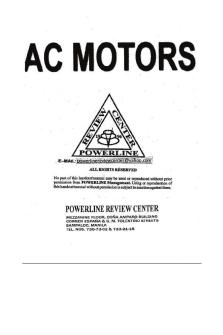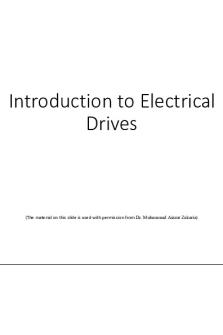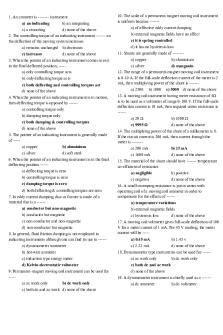EEB501 - Lab 1 INTRODUCTION TO ELECTRICAL ENGINEERING PDF

| Title | EEB501 - Lab 1 INTRODUCTION TO ELECTRICAL ENGINEERING |
|---|---|
| Course | introduction to electrical engineering |
| Institution | Fiji National University |
| Pages | 4 |
| File Size | 302.6 KB |
| File Type | |
| Total Downloads | 14 |
| Total Views | 146 |
Summary
EEB501 LAB 1 INTRODUCTION TO ELECTRICAL ENGINEERING FOR STUDENTS...
Description
EEB501 Introduction to Electrical & Electronics Engineering LABORATORY EXERCISE: 1
Title:
Resistance and Capacitance
Aim: To calculate the resistance of a resistor using colour code and digital multi-meter, and measure capacitance using LCR (L – inductance; C – capacitance; R – resistance) meter. Materials: •
4 Band Resistors – 4x Randomly picked values
•
5 Band Resistors – 4x Randomly picked values
•
Capacitors x3 – of different types.
•
Digital Multi-meter (DMM)
•
LCR Meter
Introduction: Resistors are devices that are used in various technological devices in order to control current flow and therefore making the product efficient. They can be found in any electronic equipment that uses a circuit in order to control its functions. The strength or resistance of a resistor is measured in Ohms (Ω). Resistances of standard resistors can be found by using a standardized color code. Under this code, resistors are imprinted with four bands of colors. The color code table is shown below.
-1By: Dr. Shiu Kumar
To find the resistance, the numbers associated with the first and second codes is first written next to each other. Then the multiplier, determined by the third color is multiplied to the number formed by the first two. The fourth color is the tolerance of the resistor. Since the resistance changes in different environments, it is essential to have a range of values, which are acceptable. Tolerance tells the acceptable variation of the resistor's resistance from the value predicted by the first three colors. A capacitor (originally known as a condenser) is a passive two-terminal electrical component used to store energy electrostatically in an electric field. The forms of practical capacitors vary widely, but all contain at least two electrical conductors (plates) separated by a dielectric (i.e. insulator). The conductors can be thin films, foils or sintered beads of metal or conductive electrolyte, etc. The non-conducting dielectric acts to increase the capacitor's charge capacity. A dielectric can be glass, ceramic, plastic films, air, vacuum, paper, mica, oxide layer etc. Capacitors are widely used as parts of electrical circuits in many common electrical devices. Unlike a resistor, an ideal capacitor does not dissipate energy. Instead, a capacitor stores energy in the form of an electrostatic field between its plates. The capacitor tolerance letter codes table is given below.
-2By: Dr. Shiu Kumar
Consider the capacitor below: The capacitor on the left is of a ceramic disc type capacitor that has code 473J printed on its body. Then the 4 = 1st digit, 7 = 2nd digit, the 3 is the multiplier in pico-Farads, pF and the letter J is the tolerance, which translates to: 47pF x 1000 (3 zero’s) = 47000 pF or 47 nF or 0.047 µF. Therefore, we can easily determine the value of a capacitor by just using the numbers and letters as codes on the body of the capacitor.
Procedure: Given the resistors, separate them into 2 groups; 4 band and 5 band resistors. Determine the value of the resistors using the colour code chart and record your results in the table 1 and table 2 respectively. Once complete, measure the value of the resistors using the DMM and record your results. Given the capacitors, identify if the capacitor is letter coded or not. If the capacitor is letter coded, determine the capacitance using the capacitor letter codes table and record your results in table 3. If it is not a letter code capacitance, read the label on the capacitor and determine its value. Measure the capacitance using the LCR meter and record your results.
Results: Table 1: Four band resistors No.
Resistance using Colour Code
1 2 3 4
± ± ± ±
Measured Resistance
-3By: Dr. Shiu Kumar
Table 2: Five band resistors No.
Resistance using Colour Code
1 2 3 4
± ± ± ±
Measured Resistance
Table 3: Capacitors No.
Code
1 2 3
Capacitance
Measured Capacitance
± ± ±
Discussion: 1. Define tolerance? 2. Explain the difference between general purpose and precision resistors? 3. Are the measured value of the resistors same compared to the results obtained using the colour code. If not, explain why?
Requirements: i. Please remember that all Laboratory exercise have to be supervised and results verified while it is still connected on the breadboard and signed by the Supervisor or Lecturer conducting the class. ii. Any unsigned lab sheet, when submitted will be classified as null and void.
LAB SUPERVISOR: ____________________
DATE:_________________
Due before next Lab Class
-4By: Dr. Shiu Kumar...
Similar Free PDFs

Introduction to chemical engineering
- 255 Pages

Introduction to Engineering Drawing
- 16 Pages

AC Motors101 Electrical Engineering
- 17 Pages

Electrical engineering - Wikipedia
- 18 Pages
Popular Institutions
- Tinajero National High School - Annex
- Politeknik Caltex Riau
- Yokohama City University
- SGT University
- University of Al-Qadisiyah
- Divine Word College of Vigan
- Techniek College Rotterdam
- Universidade de Santiago
- Universiti Teknologi MARA Cawangan Johor Kampus Pasir Gudang
- Poltekkes Kemenkes Yogyakarta
- Baguio City National High School
- Colegio san marcos
- preparatoria uno
- Centro de Bachillerato Tecnológico Industrial y de Servicios No. 107
- Dalian Maritime University
- Quang Trung Secondary School
- Colegio Tecnológico en Informática
- Corporación Regional de Educación Superior
- Grupo CEDVA
- Dar Al Uloom University
- Centro de Estudios Preuniversitarios de la Universidad Nacional de Ingeniería
- 上智大学
- Aakash International School, Nuna Majara
- San Felipe Neri Catholic School
- Kang Chiao International School - New Taipei City
- Misamis Occidental National High School
- Institución Educativa Escuela Normal Juan Ladrilleros
- Kolehiyo ng Pantukan
- Batanes State College
- Instituto Continental
- Sekolah Menengah Kejuruan Kesehatan Kaltara (Tarakan)
- Colegio de La Inmaculada Concepcion - Cebu











